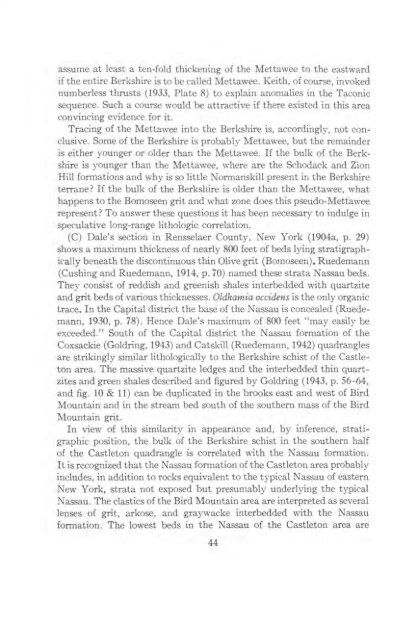STRATIGRAPHY AND STRUCTURE CASTLETON AREA VERMONT
STRATIGRAPHY AND STRUCTURE CASTLETON AREA VERMONT
STRATIGRAPHY AND STRUCTURE CASTLETON AREA VERMONT
You also want an ePaper? Increase the reach of your titles
YUMPU automatically turns print PDFs into web optimized ePapers that Google loves.
assume at least a ten-fold thickening of the Mettawee to the eastward<br />
if the entire Berkshire is to be called Mettawee. Keith, of course, invoked<br />
numberless thrusts (1933, Plate 8) to explain anomalies in the Taconic<br />
sequence. Such a course would be attractive if there existed in this area<br />
convincing evidence for it.<br />
Tracing of the Mettawee into the Berkshire is, accordingly, not conclusive.<br />
Some of the Berkshire is probably Mettawee, but the remainder<br />
is either younger or older than the Mettawee. If the bulk of the Berkshire<br />
is younger than the Mettawee, where are the Schodack and Zion<br />
Hill formations and why is so little Normanskill present in the Berkshire<br />
terrane? If the bulk of the Berkshire is older than the Mettawee, what<br />
happens to the Bomoseen grit and what zone does this pseudo-Mettawee<br />
represent? To answer these questions it has been necessary to indulge in<br />
speculative long-range lithologic correlation.<br />
(C) Dale's section in Rensselaer County, New York (1904a, p. 29)<br />
shows a maximum thickness of nearly 800 feet of beds lying stratigraphically<br />
beneath the discontinuous thin Olive grit (Bomoseen). Ruedemann<br />
(Cushing and Ruedemanri, 1914, p. 70) named these strata Nassau beds.<br />
They consist of reddish and greenish shales interbedded with quartzite<br />
and grit beds of various thicknesses. Qidhamia occidens is the only organic<br />
trace. In the Capital district the base of the Nassau is concealed (Ruedemann,<br />
1930, p. 78). Hence Dale's maximum of 800 feet 'may easily be<br />
exceeded." South of the Capital district the Nassau formation of the<br />
Coxsackie (Goldring, 1943) and Catskill (Ruedemann, 1942) quadrangles<br />
are strikingly similar lithologically to the Berkshire schist of the Castleton<br />
area. The massive quartzite ledges and the interbedded thin quartzites<br />
and green shales described and figured by Goldring (1943, p. 56-64,<br />
and fig. 10 & 11) can be duplicated in the brooks east and west of Bird<br />
Mountain and in the stream bed south of the southern mass of the Bird<br />
Mountain grit.<br />
In view of this similarity in appearance and, by inference, stratigraphic<br />
position, the bulk of the Berkshire schist in the southern half<br />
of the Castleton quadrangle is correlated with the Nassau formation.<br />
It is recognized that the Nassau formation of the Castleton area probably<br />
includes, in addition to rocks equivalent to the typical Nassau of eastern<br />
New York, strata not exposed but presumably underlying the typical<br />
Nassau. The clastics of the Bird Mountain area are interpreted as several<br />
lenses of grit, arkose, and graywacke interbedded with the Nassau<br />
formation. The lowest beds in the Nassau of the Castleton area are













